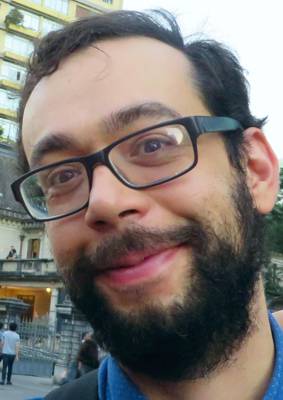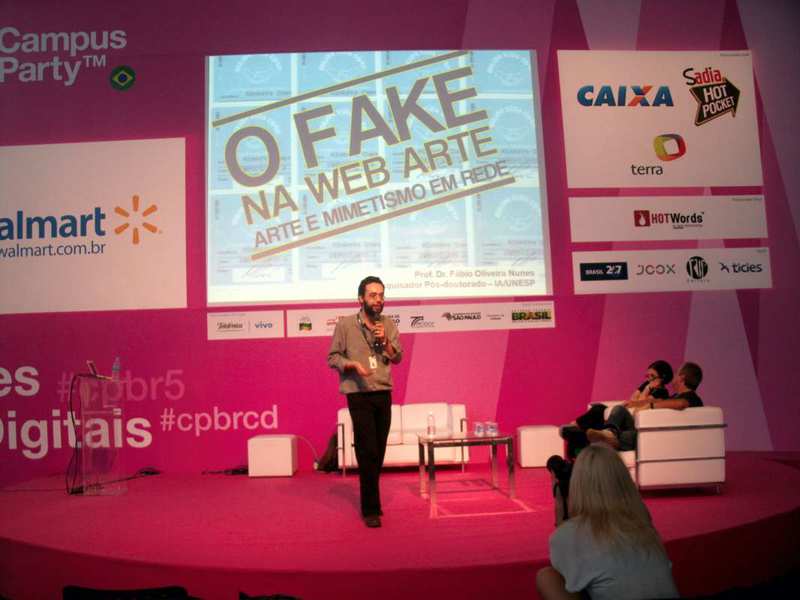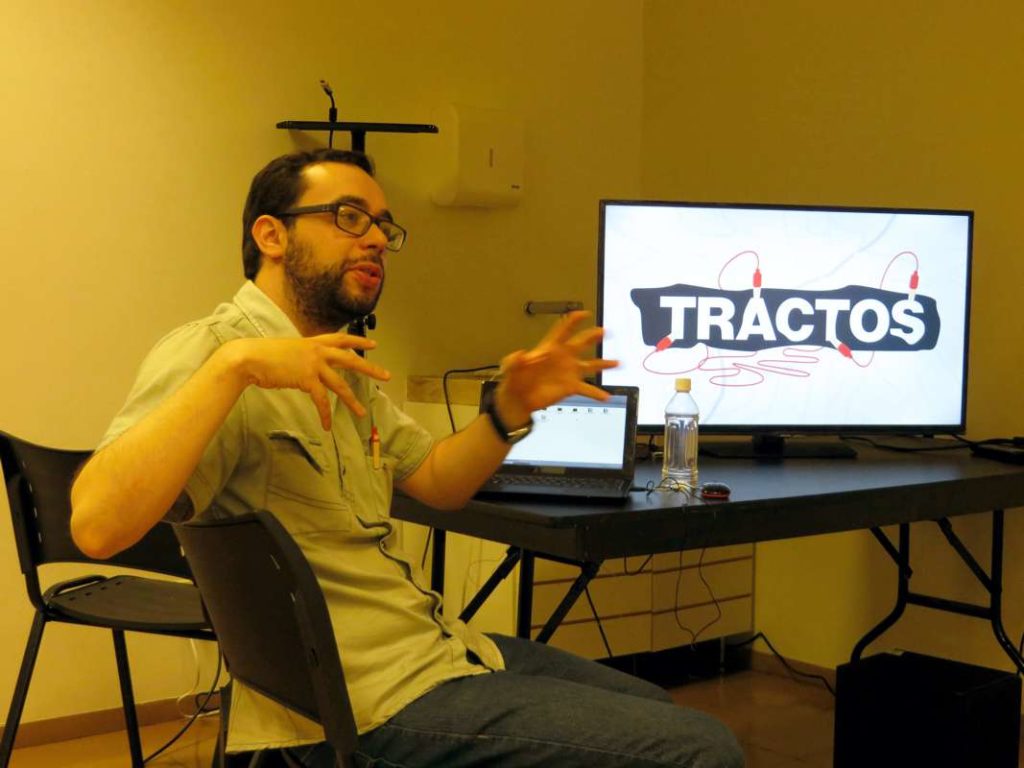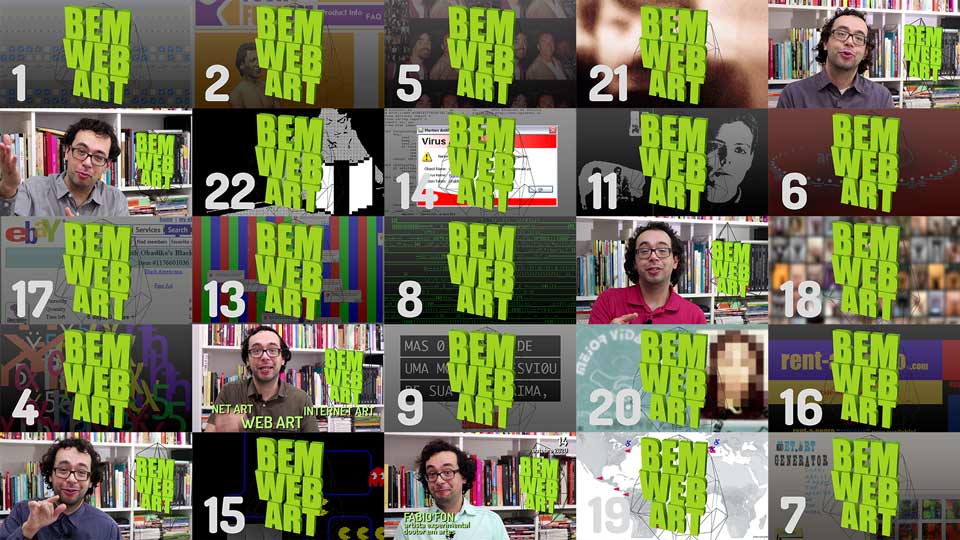
(FÁBIO OLIVEIRA NUNES) is an Brazilian experimental artist and independent researcher focused on contemporary languages, working on experimental art, visual poetics and art-technology. He holds a PhD in Arts at the School of Communications and Arts at University of Sao Paulo (USP), a Post-Doctor of Arts at the Institute of Arts at São Paulo State University (UNESP), a Master in Multimedia (Multimedia) at State University of Campinas (UNICAMP) and a Bachelor of Fine Arts at UNESP.
YEAR BY YEAR TRAJECTORY
Since the 1990s, Fábio Oliveira Nunes (or simply Fabio FON, using his acronym, stage name) has developed experiments in the arts, especially in the approach to new media. His initial experiments have a conceptual inclination inherited from the humor of cartoons, since graphic humor was his driving language in adolescence. With the commercial opening of the Internet, there is an interest in investigating the possibilities of using the digital network to create works specially created for cyberspace, which leads the artist to also become a researcher – a title he keeps with academic degrees and production reflective over the years. In 1998, he produced the website Busarte, a repository of artistic experiments for the web; in 1999, he created the ONOS website, where using Flash Technology, simulates an operating system with poetic licenses and information noise; between 1999 and 2004, he worked on sound-only interfaces in several versions of the works Dark House (Casa Escura) and Cabra Cega.
During 2000, he completed his Bachelor of Fine Arts at the Institute of Arts at UNESP (São Paulo State University), in São Paulo, with the conclusion work, “Web Art in Brazil: The telematic art created by Brazilian artists for the Internet”.
In 2002, he wrote several articles related to the research “Web Art in Brazil” in publications by UNICAMP (State University of Campinas), Faculdade Cásper Líbero and other spaces. That same year, he started teaching Computer Graphics at Faculdades Integradas de Guarulhos (SP).
In 2003, he became part of the group Digital Poetics of the School of Communications and Arts at USP. This year, he produced Artéria 8, in co-organization with the poet Omar Khouri, a digital poetry website, with the participation of about forty artists and poets from different media. Still in 2003, he defends a dissertation with the theme “Web Art in Brazil: Some poetics and interfaces in the universe of the Internet network”, where he discusses the Brazilian production of art for the Internet network, at the Arts Institute of UNICAMP.

In 2004, he started his PhD research at ECA-USP, researching the critical art of new media. That same year, he teaches at the UNESP Arts Institute.
In 2006, he produced the digital-object magazine NÓISGRANDE, launched at Casa das Rosas – Espaço Haroldo de Campos for poetry and literature, in April. In the same year, he is a contributor to the Cronópios – Literatura & Arte no Plural website, in the Internet section.
In 2007, he completed his PhD research at ECA-USP under the title “CTRL + ART + DEL: context, art and technology” on December 10. This year, he begins to carry out a series of works with the artist Soraya Braz, such as the works Roaming and Grampo, presented respectively at the II Mobilefest (SESC Av. Paulista) and at the Exhibition 27 Formas (Paço das Artes), both in São Paulo. These works make use of electromagnetic radiation sensors present in pendants for cell phones.
In 2008, he participates in Campus Party Brasil, considered the largest Internet and technology event in the world, together with the artist Soraya Braz, exhibiting and discussing the works Clip and Roaming at Campus Futuro / Mobilefest. The event was attended by more than 50,000 people. In the same year, he participated in FILE – International Electronic Language Festival (FIESP Cultural Center), in São Paulo, presenting the works Roaming and Freakpedia (made with Edgar Franco).
In 2009, he joined the faculty of the Arts Department at the Federal University of Rio Grande do Norte (UFRN), as an adjunct professor in the area of Visual Arts and Digital Technology.
In 2010, he launched the book “CTRL + ART + DEL: Distúrbios em arte e Tecnologia”, through Editora Perspectiva and FAPESP. The book raises recurring questions in the production of technological art and reflections on FON’s artistic experiments. In the same year, the work Captas (made with Soraya Braz) is presented at the Mostra SESC de Artes – São Paulo. Before that, Captas was also presented at Mobilefest, at MIS-SP, and also at other art and technology exhibitions in Brasília, Rio Grande do Norte and Rio Grande do Sul. Still in 2010, Fabio FON launches the interinstitutional project 10 Dimensions: Network, Body, Art and Technology Dialogues (UFRN-UFPB-IFRN-FAPERN), under his coordination. In ten different monthly meetings, the project presented discussions and works on art, science and technology with the presence of researchers from different regions of Brazil, in Natal (RN) and João Pessoa (PB).
In 2011, he participated in FILE Porto Alegre and FILE São Paulo, the latter with the work Via Invisível. He returns to São Paulo, leaving his position as professor at UFRN and joining the Research Group cAt: Science, ART and Technology, a team under the coordination of Prof. Dr. Milton Sogabe (UNESP). Participates in the Paradas em Movimento: Videopoetics Exhibition at Centro Cultural São Paulo, curated by Elson Fróes, with poetic videos.
In 2012, he starts post-doctoral research at the UNESP Arts Institute, in São Paulo, with the support of FAPESP – São Paulo State Research Support Foundation, under the theme “Mimicry: Relational strategy in Art and Technology” . That same year, he participated as a speaker at the fifth edition of Campus Party Brasil, in São Paulo. Participates in Faro (Portugal) at ARTECH 2012 – International Conference on Digital Arts.
In 2013, as a member of the organizing committee, he participated in the design and production of the 4th International Meeting of Research Groups: convergences between art, science and technology & mixed realities, an event that brought together researchers from different countries such as Colombia, China, South Korea, Africa do Sul and Brazil, at the UNESP Arts Institute, in São Paulo. Participates in Lisbon (Portugal) of the CSO – Congress Creators on Other works. The book “CTRL + ART + DEL: Distúrbios em Arte e Tecnologia” is indicated as one of the bibliographic references for art teachers in the state public education of São Paulo, among other titles that “justify and guide the organization of exams, competitions and selective processes ”for educators across the state.
In 2014, he launched the experimental magazine Alteria, a publication that brings together different visual invoices from creators under a state of alterity: all are pseudonyms, alteregos or personas. His postdoc is completed this year. Still in 2014, he is part of the team for reformulating content and propositions of Curricular and Didactic Art Guidelines for the 3rd grade of Secondary Education of State Schools in São Paulo.
In 2015, together with the artist Soraya Braz, she developed the Tractos Project, a series of actions in bordering regions of the São Paulo Metropolitan Region with the objective of creating tactile-sound-interactive maps in collaboration with the living people of these regions. The project is supported by the Cultural Action Program of the São Paulo State Secretariat for Culture. In the first semester of this year he participates in ARTECH 2015 – 7th International Conference on Digital Arts in Óbidos (Portugal) as a communicator. Still this year, he is curator of the WebArte.BR: Brazilian artistic experiences on the Internet, organized by SESC São Paulo.
In 2016, together with the artist Soraya Braz, she develops the project Autômatos Poéticos – workshop-laboratory for the development of creative experiments based on conversation robots – an initiative awarded by the Cultural Action Program of the São Paulo State Secretariat of Culture. Poetic Automata is initially carried out at Casa das Rosas – Espaço Haroldo de Campos de Poesia e Literatura, in São Paulo. Then, the project is carried out in other spaces, such as SESC Campinas, in the interior of São Paulo, and SESC Arsenal, in Cuiabá, Mato Grosso. Also in 2016, he launched the book Mentira de artista: arte (e Tecnologia) that deceives us into rethinking the world, with the launch of a cycle of launching in neighboring regions of São Paulo.
In 2017 and 2018, he is part of the experimentation, creation and poetic laboratory “Cooperativa da Invenção” at the Haroldo de Campos Reference Center of the literary museum Casa das Rosas, in São Paulo, teaching and guiding participant projects jointly with Lucila teachers Tragtenberg and Julio Mendonça.
In 2019, with Soraya Braz, she resumed the realization of the Autômatos Poéticos project, with a new execution at SESC Arsenal, in Cuiabá, Mato Grosso, Brazil.

Between 2020 and 2022, during the COVID-19 pandemic, Fabio FON dedicated himself to creating web series aimed at promoting artistic production designed for the Internet. This endeavor was undertaken in a context where all artistic production was directed towards the online realm. First, he developed the series ‘BEM WEB ART,’ dedicated to historic internet artworks still accessible, in its first season. In the second season, he featured recent works created during the first pandemic year. He also produced the series ‘Voices of Web Art in Brazil,’ showcasing and commenting on celebrated internet-based works by prominent Brazilian artists. In the same vein of generating content for research promotion, the video ‘What is web art?‘ was created. This video, awarded by the Cultural Action Program of the State Secretary of Culture and Creative Economy of São Paulo, presents a reflective approach to artistic production for the Internet.”

Automatic translation of the original page in Portuguese.